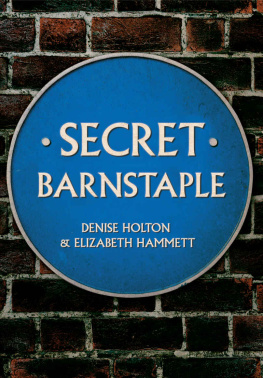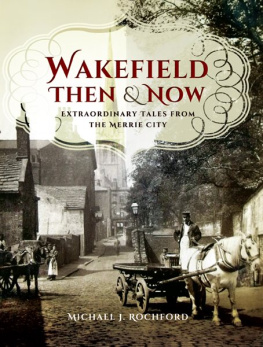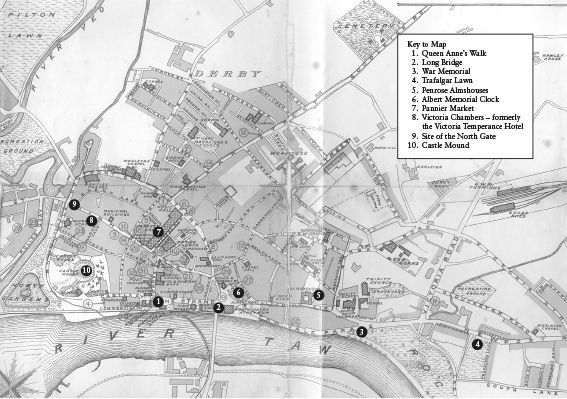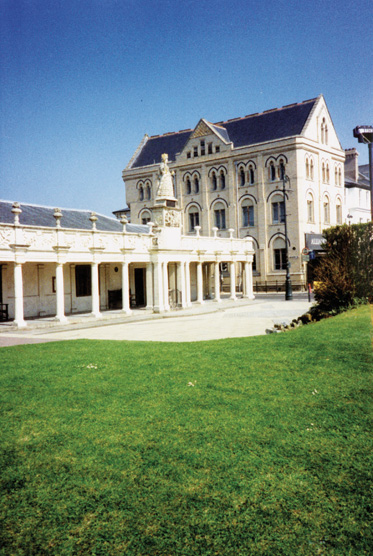First published 2015
Amberley Publishing
The Hill, Stroud
Gloucestershire, GL5 4EP
www.amberley-books.com
Copyright Denise Holton and Elizabeth Hammett 2010, 2015
The right of Denise Holton and Elizabeth Hammett to be identified as the Authors of this work has been asserted in accordance with the Copyrights, Designs and Patents Act 1988.
ISBN 9781445642840 (PRINT)
ISBN 9781445642970 (eBOOK)
All rights reserved. No part of this book may be reprinted or reproduced or utilised in any form or by any electronic, mechanical or other means, now known or hereafter invented, including photocopying and recording, or in any information storage or retrieval system, without the permission in writing from the Publishers.
British Library Cataloguing in Publication Data.
A catalogue record for this book is available from the British Library.
Typesetting by Amberley Publishing.
Printed in Great Britain.
Contents
Introduction
The history of Barnstaple is a long and distinguished one, with much change over the centuries. It has been through good times and bad, and experienced prosperity and hardship, but it has remained the same in so many ways. Our aim in this book is to take you on a gentle tour of Barnstaple, and in the process inform and entertain the reader with facts about the town some you may know, but hopefully many you may not.
The book is designed to be used as a guided walk around historic Barnstaple, with the book as your guide. The tour starts at Queen Annes Walk the beautiful Grade I listed, eighteenth-century colonnade, and continues around the town, taking in the many historic sites. The reader will discover the stories of the buildings and businesses, and the accounts of the people who lived and worked in them.
The story traditionally begins in 930 the date in which Barnstaple claimed to have received its first charter. The basic layout of the town was already in place. Boutport Street and the High Street were in existence with a strong defensive wall surrounding the town.
Barnstaple was one of four burhs and as such was allowed to mint coins. The earliest known coin made here dates back to King Eadwigs reign (95559). The town was also an important centre of commerce. Its old name Bearde Staple means the Market or Staple of Bearda. According to tradition, King Athelstan granted the town a charter with rights to hold markets and a fair.
By 1066, Barnstaple was a well-established town, and twenty years later was mentioned in the Domesday Book. The King held the Borough of Barnstaple for himself, and it was not until Henry I came to the throne that the first Lord of Barnstaple, Judhael of Totnes, was created. It was Judhael who, in 1107, founded the priory of St Mary Magdalene outside the town wall.
By 1290, Barnstaple had become an important trading centre, for wool in particular, and five years later sent two burgesses to represent the town in parliament.
The late sixteenth and early seventeenth centuries were the most exciting period in Barnstaples development. The Great Quay was built at this time, leading to a great increase in trade. Tobacco was imported from the New World, and pottery, tools, cloth and other goods were exported in return. In 1603 work began on the building of a new quay, to cope with the expanding trade.
In 1642, the Civil War began. Barnstaple was first held by the Parliamentarians, but changed hands four times before the end of the war. After the war, Barnstaple settled down and established its position as a port and industrial centre, and in the eighteenth century Queen Annes Walk was created in its present form as a merchants exchange. Marshy land at the end of the bridge was drained and, in 1710, the first proposals were made to create a formal Square. Several roads leading to Barnstaple were repaired and widened after George III passed an act requiring this work to be carried out.
In 1825, steam was used for the first time in Barnstaple to power lace bobbins at the Derby Mill factory, and a year later the present guildhall was built, replacing the old guildhall (actually Barnstaples second), which stood at the entrance to the churchyard. During the first half of the century, the population had doubled to 8,500, and by 1835 the towns boundaries were extended to include Pilton and Newport. There was much redesigning taking place and, in 1854, the BarnstapleExeter railway opened.
The continuing silting of the River Taw resulted in the running down of Barnstaple as a port, and, as time passed, the major part of the woollen industry moved to other parts of the country with other, larger ports taking much of Barnstaples trade.
However, the twentieth century saw a gradual resurgence of Barnstaples fortunes with several major firms settling in the town at Pottington and Roundswell. As we move further into a new century, Barnstaple continues to flourish as the chief town of North Devon.
Map c. 1895.
1. The Strand and The Long Bridge
Our historical walking tour of Barnstaple begins at Queen Annes Walk on The Strand now home to Barnstaple Heritage Centre. A merchants walk or exchange has existed here since the seventeenth century, and early maps show the site standing alone jutting into the river. The prosperous merchants, who would spend their time here, all put money towards the building of a sheltered area to offer some protection from rain and wind when carrying out their business by the quay. The heraldic crests of those who contributed can be seen carved into the faade either side of the central statue of Queen Anne. The present structure dates from the early eighteenth century, but the columns may date from an earlier structure.
Queen Annes Walk was the second merchants walk erected here.
In 1859, Queen Annes Walk was said to be rapidly falling into decay. Some entrepreneurs came to an agreement with the town council to erect some public baths and washhouses next to the Walk, as well as to refurbish the Queen Annes Walk buildings. The completed work was officially inaugurated on Saturday 15 October when the mayor and around 100 dignitaries and local gentlemen paraded down Cross Street, led by a brass band. At the new building they sat at a long table and drank many toasts in port and sherry, including one to R. D. Gould who supervised the rebuilding.
They then marched back to the guildhall where the national anthem was played and cheers given for the mayor, who had also provided a cask of ale for the workmen and sent a half-dozen of wine to the station house for the use of the police, Beadles, etc.
The Tome Stone was placed on the quay in 1633 to replace an earlier stone. Merchants would seal their bargains here by placing their money on the stone, agree a price and then shake hands before witnesses. Similar stones at Bristol and other places are called nails, hence the expression paying on the nail. There are several names of merchants of that time engraved around the edge of the stone, one in particular John Delbridge was one of the most well known of his age.
The Tome Stone has been on this site since 1633.













